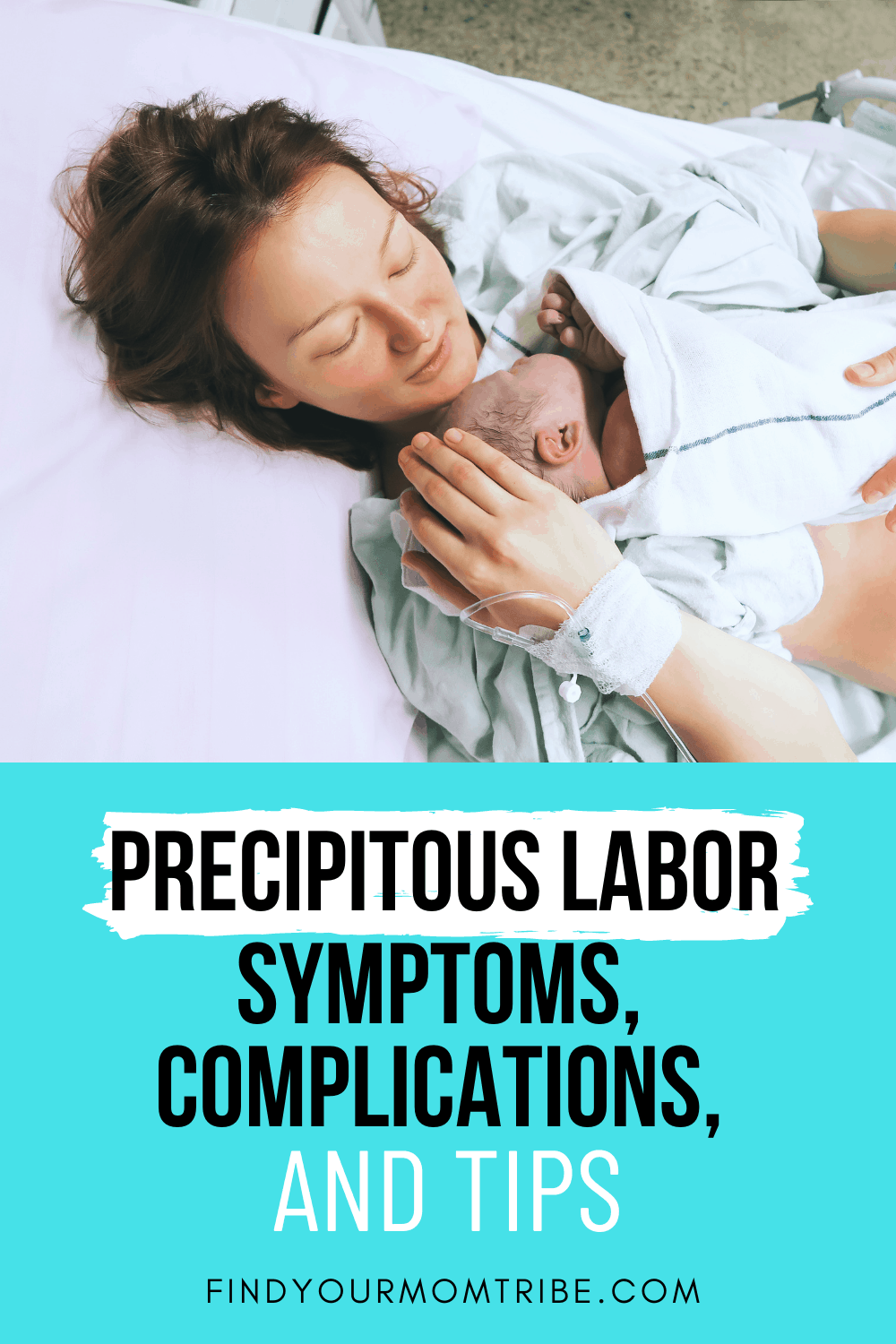Giving birth can be a long journey for many moms unless you have precipitous labor. If you’re not sure what this term means, try to remember the last time you saw a movie where a woman gave birth faster than the speed of light.
Precipitous or fast labor refers to when a pregnant woman gives birth within 3 hours of the onset of regular contractions, much like they do in TV shows and movies. In real life, however, this is not as common.
In fact, first-time moms can spend up to 30 hours in labor while women who have previously given birth might need up to 15 hours to deliver their baby.
Initially, the idea of giving birth at lighting speed might seem like the preferred option as opposed to spending hours or even a full day in labor but a precipitous delivery carries a number of risks for both the baby and the mother.
The experience can be very difficult emotionally as the woman can feel as though she has lost control of her birth plan and the entire process of giving birth, and it’s not unusual for women to be left in shock by the rapid delivery.
There is the potential for physical complications as well. Perineal tearing and even postpartum hemorrhage can occur as a result of giving birth quickly, making the recovery from childbirth longer and more difficult.
But the baby can suffer from complications, too. For example, the baby might breathe in some of the amniotic fluid and there is a higher risk of infection.
Although there are certain factors that put you at a higher risk of precipitous birth, it can happen to anyone, which is why it’s important to read up on its signs, symptoms, and what to do in case it happens to you.
What Is Precipitous Labor?

Under regular circumstances, a woman gives birth for somewhere between 3 and 30 hours (if this is her first time giving birth) and 3 and 15 hours (if she has given birth before).
In both cases, it’s a large window of time which is why it’s not uncommon to hear a woman say she was in labor for a whole day.
In the case of precipitous labor, or rapid labor, a woman gives birth within 3 hours.
The time of labor is measured from the point when regular contractions begin.
The Symptoms

Naturally, first-time pregnant women might be concerned that they’ll experience fast labor and give birth while in the car on their way to the hospital, for example. This is unlikely to happen.
Here’s a quick overview of the precipitous labor symptoms:
- Contractions intensify quickly into the labor;
- Contractions quickly become close to one another;
- You feel like there are no pauses between contractions or feel like you’re having one long contraction;
- You feel like you need to push shortly into the labor.
To avoid a precipitous delivery somewhere where you and your baby can’t get immediate medical attention, you first need to pay attention to your contractions.
In the early stages of labor, there isn’t much rhyme or reason to your contractions. They are usually sporadic and aren’t as painful as those that come along later on in the labor.
Once the dilation of the cervix starts, the uterine contractions become more intense and arrive in a consistent pattern – usually, this process takes several hours.
But, during rapid birth, the contractions speed up quickly and are very close to one another even though only a short period of time has passed.
Another sign to look out for is feeling the need to push even though your labor has just started (it can feel like a bowel movement) or feeling like there are no pauses between the contractions – they can actually feel like one prolonged contraction.
For first-time moms who aren’t familiar with the birth experience, it’s important to keep these symptoms in mind so they can get to a delivery room as fast as possible if needs be.
If you suspect that you’re experiencing precipitous birth, don’t hesitate to call your doctor, midwife, or doula. They’ll be able to verify that you are in rapid labor and will tell you what to do next.
Precipitous Labor And Delivery – What You Should Do

Many OB/GYNs claim that even though there are certain women who are at a higher risk of having a precipitous birth, it is generally difficult to estimate whether a woman will have it or not.
As a result, you should keep the following steps in mind if you find your labor is progressing much faster than expected.
Here’s a quick overview:
- Call your doctor and/or 911;
- Make sure you’re not alone;
- Lie down and do breathing exercises;
- Prepare for an unplanned home birth if you can’t make it to the hospital.
Obviously, the first step is to call your doctor or midwife and let them know the details of your labor so far. Call the emergency services if you feel like you’re going to give birth soon.
If you’re alone at home, make sure to call someone you trust and feel comfortable with to come over and be with you as you shouldn’t be alone at this time. You should lie down, preferably on your side, in the cleanest area of your home, and breathe deeply.
It’s common for women who experience fast labor to have an unplanned home birth, so it’s also useful to know what you should do in case you need to deliver at home instead of the hospital where you had originally planned your birth.
In addition to following the above steps, make sure that the room you’re in isn’t cold as babies need warmth. If you’re lying on the bed, you can protect the mattress by first covering it with large plastic bags and then placing a clean sheet over the bags.
You can bring out a blanket for your baby to be wrapped in, as well as a hat. Prepare towels, too, and a bowl for the placenta.
It might seem logical to lay down in a tub but this is not a comfortable place in which to give birth and it might be difficult for the emergency medical personnel to provide you with immediate care once they get to your house, so laying on the bed or floor is preferable.
If you give birth before the emergency personnel arrives, don’t cut the umbilical cord on your own as it’s still delivering oxygen to the baby, which is extremely important in the first few minutes after birth, especially if it takes the baby more than a minute to start breathing.
Are You At An Increased Risk Of Precipitous Labor?

If you have never given birth before, the idea of going into rapid labor is understandably a little terrifying.
Even though precipitous labor is not a common occurrence for pregnant ladies and only a small percentage of women experience it, there are certain risk factors that increase your chances of rapid delivery.
Here’s a quick overview of what puts you at an increased risk of precipitous labor:
- You previously had a rapid birth;
- Baby has low weight;
- Birth canal doesn’t provide much resistance;
- Uterus can provide strong contractions;
- You have preeclampsia;
- You had a placental abruption.
According to the American Pregnancy Association, women who previously had a rapid birth are at an increased risk of experiencing it again.
In addition, your chances of precipitate labor increase if your baby’s birth weight is expected to be lower than is common or if you have a very strong uterus that can provide powerful contractions.
Women whose birth canal doesn’t provide a lot of resistance during labor or who have preeclampsia can also give birth very quickly.
If you had a placental abruption (an event in which the placenta and uterus become detached before birth) you might also be at an increased risk of fast delivery.
That being said, sometimes a woman who is perfectly healthy and doesn’t have any complications during pregnancy can also have a precipitous delivery, so there is no method that can predict how you’ll give birth with a 100 percent accuracy.
Making all the necessary preparations prior to your due date and feeling like you are ready to welcome your child and give birth can make you feel more in control of the situation, regardless of what happens.
Rapid Labor Complications And Consequences

At first, giving birth quickly sounds a lot better than spending what seems like an eternity in active labor, managing wave after wave of painful contractions. Plus, it sounds like it could make for an exciting birth story, right? Well, there’s more to rapid labor than meets the eye.
Here’s a quick overview of the possible complications and consequences to the mom and baby:
- Emotional distress;
- Postpartum hemorrhage;
- Perineal tearing;
- Infection;
- Shoulder dystocia;
- Baby breathes in amniotic fluid.
First of all, realizing that you’re about to give birth much more quickly than is typical can be terrifying and have a serious impact on the mother’s emotional state during a very sensitive moment in her life. Usually, the birthing plan goes out of the window.
There is no time to get accustomed to the pain of the contractions and it can cause the mother to feel like she has no control of the situation, turning the labor into a scary experience instead of one where she feels like she’s on top of what’s happening.
Even more significant is the fact that getting an epidural or any other pain relief might not be possible, leading to an entirely different birthing experience than was expected, which can cause the mother to feel disappointed or sad with the way things turned out.
When it comes to physical complications, there is the risk of postpartum hemorrhage which refers to heavy loss of blood immediately after giving birth. Under regular circumstances, the uterus contracts after giving birth, which prevents heavy bleeding.
But if the uterus doesn’t contract, causing a condition referred to as uterine atony, it results in heavy bleeding and postpartum hemorrhage.
This condition is so serious that it can lead to death, although this outcome is much rarer in countries where healthcare is at a high level, such as the United States.
During a normal vaginal delivery, your body has time to adjust to the passage of the baby through the birth canal. However, during rapid labor, there is a higher risk of serious lacerations to the perineum and cervix because the body didn’t have enough time to stretch and adjust.
Perineal tearing can take some time to heal, depending on how severe it is.
But, the mother isn’t the only person whose health is at risk. The baby can experience health complications, too.
The first risk to the baby is infection. Due to the speed of the delivery, the medical staff might not have enough time to properly follow all sterilization procedures.
Some moms might not even have enough time to make it to the hospital, which means they’ll give birth in an environment that can be potentially dangerous to the baby.
There’s also an increased chance for shoulder dystocia which refers to when the shoulder of the baby becomes caught above the pubic bone after the head has already been delivered. In the event of shoulder dystocia, it’s important to have medical staff on hand who will intervene right away so that your baby can be born and start breathing.
Even if you’re having a home birth with just a midwife present, they’ll know what to do to deliver your little one safely.
There’s also a chance that the baby might breathe in some of the amniotic fluid and experience more fetal stress because the speed of the delivery and contractions are so intense.
As already mentioned, apart from the possible physical complications of precipitous labor, there are also the emotional complications to consider. They can have a serious impact on the mother’s well-being and increase the level of attention and postpartum care she needs.
Final Thoughts
In this day and age, it’s natural and expected for the mom-to-be to be in charge of how her labor will proceed.
Whether she schedules a C-section or opts for a vaginal delivery at home, having control over this monumental experience helps get motherhood off to a good start.
However, despite your best planning, there is always a chance that you’ll have a precipitous labor, especially if you’re already at an increased risk of fast labor.
Although I have my fingers crossed that everything goes according to plan, it’s always better to be prepared, know how to recognize the signs, and understand what you need to do so that your little one can be born in the safest and best way possible.
Remember that your body was made to do this – even if giving birth turns out to be different from what you had in mind. All that matters, in the end, is that you’re holding your healthy and happy baby in your arms!
References:
- “Rapid Labor” by the American Pregnancy Association. Published on American Pregnancy on August 21, 2014. Accessed October 13, 2020.
Like this post? Please share or pin it for later. You can also stay in the loop and follow us on Facebook, Instagram or Pinterest.

This post contains affiliate links. Please see our full disclosure for more info.

